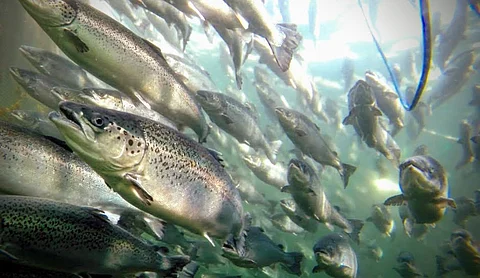

The Institute of Marine Research has submitted a consultation response to Norway's impact assessment of offshore aquaculture.
Photo: Frode Oppedal / Institute of Marine Research
"We know too little about offshore aquaculture to start large-scale production," according to the Norwegian Institute for Marine Research.
The Institute has issued its official response to a Norwegian government consultation on offshore aquaculture development in three potential marine zones, following an impact assessment carried out by assurance and risk management firm DNV, commissioned by the Norwegian Ministry of Trade, Industry and Fisheries.
In the Institute's view, too little research evidence exists regarding the potential environmental impact of offshore aquaculture development, in addition to "great uncertainty in the impact assessments for various animals and ecosystems both in the water column and on the seabed".
The most significant uncertainties, the Institute states, are related to fish welfare, parasites and disease transmission to wild fish - specifically migrating wild salmon smolt - in addition to possible impacts on marine mammals, and the effects of potential fish escapes on salmon stocks.
"We know too little about the migration routes of salmon smolts when they leave the fjords and swim out to sea, and how much [time] they spend in areas relevant for offshore aquaculture," said marine scientist Vidar Wennevik, in a press release.
With regard to Frøyabanken, one of the potential offshore aquaculture zones considered in the impact assessment, Wennevik warns that this risks impacting wild smolt.
"This area potentially overlaps with where wild salmon smolt swim when they emerge from the Trondheimsfjord and go on a grazing migration to the sea. It is in this area in Norway where we have the largest concentration of wild salmon smolt on migration. We do not know how they will be affected if large fish farms are built on this migration route," he explained.
The researchers also highlight disease and parasites transmission risk at another of the proposed zones, Norskerenna Sør. "This area is so small that there could be major challenges with infection between the clusters that will be distributed within the field," said Wennevik.
Lack of knowledge about salmon migration routes also means that wild fish could be affected by potential infections among farmed fish populations, the researchers say.
Furthermore, Wennevik says, "There is no knowledge about what happens to farmed salmon that escape from facilities located far from the coast and closer to the areas where wild salmon reside."
The Marine Institute researchers also point out that developing offshore aquaculture adds to existing human impacts on marine ecosystems, including fisheries, pollution and shipping.
"Several marine mammal species travel in and near the candidate locations, but there is not enough detailed knowledge about how marine mammals may be affected by the loss of area as well as noise and various emissions from the farming activity," the Institute states.
However, the Institute says, if Norwegian authorities decide to proceed with offshore aquaculture despite these uncertainties, it "recommends a gradual increase in the amount of fish that can be produced in such facilities".
"Such an increase must be combined with continuous and standardized monitoring of fish welfare and environmental impact," said Wennevik.
The Institute states that careful monitoring "can reveal negative consequences while also allowing for the assessment of opportunities for sustainable growth, or conversely; the need for mitigating measures such as reductions in biomass or different production cycles between plants within the fields."
The response from the Norwegian Institute for Marine Research contrasts with that of the Norwegian Directorate of Fisheries, which recently released its own consultation response indicating its support for offshore aquaculture in the three zones, despite the potential risks highlighted in the DNV report.
